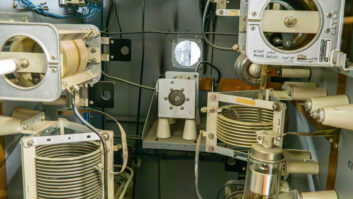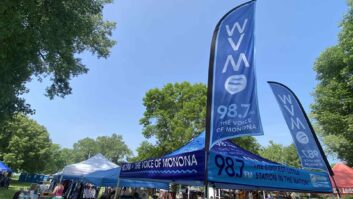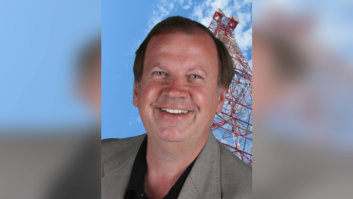
Several current and past board members of the Association of Public Radio Engineers posed at PREC: Steve Johnston, Wisconsin Public Radio; Victoria St. John, Vermont Public Radio; Paxton Durham, WVTF Public Radio; Jobie Sprinkle, WFAE; Shane Toven, Linear Acoustic; Jonathan Clark, Shively Labs; John George, RF Specialties; Dan Houg, KAXE/KBXE Northern Community Radio; Daniel Mansergh, KQED Public Radio; and Pierre Lonewolf, KOTZ Kotzebue Broadcasting
Photos by Jim Peck The Association of Public Radio Engineers met this spring for its 10th annual conference. APRE President Dan Houg of Northern Community Radio in Grand Rapids, Mich., said, “Attendance, sponsorships and insights shared were at their peak. This was a coming of age event for the association as the last of the founding board, Dan Mansergh of KQED, term-limited off the leadership.”
Ralph Hogan, founding president of APRE, was honored with the association’s Lifetime Achievement Award at a Friday night banquet.
“It is immensely gratifying to see the association doing so well in terms of membership, conference attendance, sponsor support and overall quality of the activities,” Hogan said.
“Everything is run so professionally, it is hard for people to believe this is an all-volunteer organization. I think I speak for all of the founders in congratulating the current APRE leadership for taking the organization to the next level of relevance, leadership and quality of services.”
IN HARMONY
Several sessions stood out.
Of note was one led by Gray Haertig of Haertig Associates in Portland, Maine, and Michael LeClair of WBUR, Boston, with support from Jeff Welton at Nautel offering a live demonstration of the 12th-order harmonic of how an NCE FM station could affect an LTE system’s operation.
LeClair, who also contributes to Radio World, demonstrated how signals as low as –124 dBc could force a 64 QUAM signal into throttling back to lower levels of throughput in coping with the residual carrier radiation. It gave the room a much better sense of the math and physics involved as well as the best means to address the issues for common solutions.

Content Depot, the content delivery operating enterprise of the Public Radio Satellite System, was in focus as Jim Duff and David Gray highlighted the progress and benefits of deploying the MetaPub system for pushing network provider program-associated data through the most common middleware vendors, including Tagstation, Jump2Go, Broadcast Electronics, ENCO, ArticPalm and Wide Orbit.
Duff noted that metrics from NextRadio point to much higher usage and satisfaction with stations that are visually appealing. MetaPub is new real-time story-by-story content with text, images, links and station information all capable of being indexed.
NPR’s Michael Beach noted that the system can also be useful to transmit text info during EAS, similar to what NPR has demonstrated for public radio seeking to send text messages for use by the deaf and hard-of-hearing constituencies.
During the conference, KNPR(FM) in Las Vegas was providing MetaPub data on all three of the HD channels. Duff also highlighted an increased focus on enhancing security measures by detecting unusual activities, and enhancing PRSS’s extensive performance and impairment tracking metrics. “You can’t improve what you’re not measuring,” he said.
BIRD PLANS
Beach, the vice president for NPR Distribution, talked about plans and timetable for the next-generation satellite system.
Funding uncertainties have resulted in a changing focus from the theoretical benefits of distribution via interactive solutions that a terrestrial transformation might provide. Towards that end, an RFI for vendors related to system improvements will be shopped this year, and next steps will be dependent on the availability of funds. Beach said station options for replacement equipment can be divided by 24 for a two-year purchase, which makes it now an op-ex budget, rather than cap-ex purchase.
There were a number of other interesting presentations.

APRE presented Ralph Hogan, right, its founding president, with a Lifetime Achievement Award. He was with Jonathan Clark. John Ahern of Davicom talked about SNMP and the fundamental architecture and directions underway on all manner of SNMP-enabled devices. He commented, “Most exciting new discoveries are heralded not by ‘Eureka!’ but ‘That’s funny …’” Grounding basics at transmitter sites were covered by Jeff Welton of Nautel with lots of practical advice and case studies.
Michael Dosch of Lawo noted that multitouch control on the screen is the way of the future even for consoles, and has for some time been the last big issue to solve. He notes that today, even haptics (tactile feedback) is making great strides for the disability community and that the industry should stay tuned as these approaches are improving substantially.
Steve Dove of Wheatstone talked extensively about the philosophy and audio architecture of the Vorsis product line. Kirk Harnack of the Telos Alliance discussed multi-rate streaming, Rich Redmond of GatesAir spoke extensively on the likely impact to radio stations of the pending TV spectrum repack. Corey Edwards of Dieletric talked about the efficiencies of manifold combiner design.
Attorney Melody Virtue of Garvey Schubert Barer spoke about a variety of regulatory matters, especially translators and repacking and the FCC’s “work it out” stance on cellular vs. FM interference matters. She also cautioned stations that the new 250-mile modification allowances for translators for AM stations are being acted on by the FCC within just weeks so stations can be blindsided if unaware of potential interference issues. “Translator stations are like poker chips,” she told APRE.
Steve Lampen of Belden told the group that the best analog cables are digital cables because the capacitance is so low. “A –90 dB noise floor from digital is more nothing than you’ve ever heard.” David Layer of the National Association of Broadcasters updated the group on Pilot, the new name and focus of the unit formerly known as NAB Labs; he showed the group how all-digital AM lab testing resulted in a SNR that is 10 dB worse than the existing signals. Society of Broadcast Engineers President Jerry Massey highlighted the society’s increased focus on training the next generation of engineers, while Chris Crump of Comrex focused on dedicated bandwidth solutions and security concerns. Crump told the group, “Web RTC is basically going to be the way we make phone calls in the future.”
Finally, Rhode Island Public Radio’s Aaron Read and Tony Peterle of Worldcast Systems showcased an RIPR implementation of SureStream Reliability on an existing IP codec link, noting it was powerful in reducing network errors and works well with DHCP.
PowerPoints of the presentations are available to PREC members on the website apre.us.







